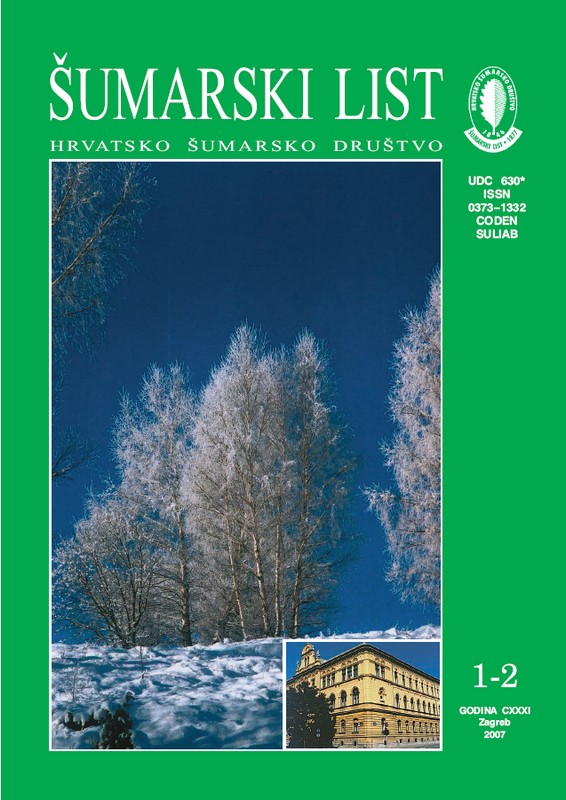
broj: 1-2/2007
pdf (22,2 MB) |
|
||||||||||||||
| IZVORNI ZNANSTVENI ČLANCI | ||
| Božić, M., J. Čavlović, M. Vedriš, M. Jazbec | UDK 630* 523 (001) | |
| Modeling Bark Thickness of Silver Fir Trees (Abies alba Mill.) pdf HR EN | 3 | |
| Ballian, D., F. Bogunić, M. Konnert, H. Kraigher, M. Pučko, G. Božič | UDK 630* 165 (001) | |
| The Analysis of Genetic Variability of Norway Spruce (Picea abies (L.) Karst.) Subpopulation at the Igman Mountain pdf HR EN | 13 | |
| Majnarić. D. | UDK 630* 156 (001) | |
| Harvest and Mortality of the Brown Bear in Gorski Kotar pdf HR EN | 25 | |
| PRETHODNO PRIOPĆENJE | ||
| Bezak, K., D. Kuric, M. Vrebčević | UDK 630* 612 | |
| The Dissipative Structure of High Forests of Pedunculate Oak (Quercus robur L.) in the Management Unit “Slavir” pdf HR EN | 35 | |
| Summary: Forests are chaotic nonlinear dynamic systems, whose condition changes in accordance with the patterns dictated by the laws of nature. The authors investigate the dissipative condition, growth rate and production of pedunculate oak stands (Quercus robur L.) in the management unit Slavir. They apply the Theory of Nonlinear Dynamical Systems and the Theory of Dissipative Structures in their research. Using complex equations of growth and development of diameter and height structures, the authors analyze the condition and speed of growth of pedunculate oak high forests. According to the Theory of Dissipative Structures, stands are classified into the following categories: balanced, periodic, non-periodic and chaotic. Dissipative forests are equilibrium, near-equilibrium and far-from-equilibrium systems. The concept of dissipative structures, coined by the Belgian chemist and physicist Ilya Prigogine, accounts for the coherent behaviour in far-from-equilibrium systems. This concept explains a close link between structures and order on the one hand and dissipation on the other. The Theory of Dissipative Structures deals with a tendency from order towards disorder and increasing entropy. According to the Second Law of Thermodynamics, while entropy increases, energy is lost irreversibly. Energy dissipation, which is irreversible at the molecular level, is followed by an opposite process of orderly chaos at the subatomic level. According to Prigogine, dissipative structures are islands of order in the sea of disorder. They maintain and increase their order by increasing the disorder of their surroundings. A map of a dissipative structure of pedunculate oak (Quercus robur L.) high forests was made for the management unit Slavir. Standard height series were constructed for the first site class. Parameters of regression series of current annual diameter increment were obtained by iterations for each particular stand condition. Volume yield tables and tables of monetary values of wood assortments in the first site class were constructed for the dissipative stand structure. There are significant differences in the production and monetary value of wood assortments for the dissipative structure of pedunculate oak (Quercus robur L.). Young stands aged 20 and less in the phase of first increment culminations, covering areas of 1,204 ha and having a dissipative structure, denote the initial condition. A characteristic feature of chaotic systems is their sensitive dependence on initial conditions. Even the slightest biotic and abiotic disturbance may cause a nonlinear retroactive effect. Stands in a balanced condition over 621 ha are predominantly young and cannot be compared to older stands in a periodic, non-periodic and chaotic condition. The stands in a periodic condition extend over 1,295 ha. Their density is 0.86, the increment amounts to 7.10 m3/ha, the average stock is 347.7 m3/ha and the monetary value of wood assortments is 156,441 kuna per hectare. The stands in a non-periodic condition cover an area of 3,720 ha. Their density is 0.86, the increment is 6.71 m3/ha, the average stock is 352.2 m3/ha and the monetary value of wood assortments is 162,450 kuna per hectare. The stands in a chaotic condition cover an area of 1,004 ha. Their density is 0.80, the increment is 5.61 m3/ha and the average stock is 352.8, whereas the monetary value of wood assortments amounts to only 65,048 kuna per hectare due to dieback. The research results are a pathway to modeling multi-dimensional forest dynamics, which leads to multipurpose and sustainable management. Key words: complex equations; dendrograms; dissipative structures; nonlinear dynamical systems; sustainable management. | ||
| PREGLEDNI ČLANCI | ||
| Trinajstić, I. | UDK 630* 164 | |
| About the Problem of Differentiation Between the Oaks Quercus pubescens Willd. and Quercus virgiliana. (Ten.) Ten. pdf HR EN | 57 | |
| Sabadi, R. | UDK 630* 721 + 722 | |
| Promotion of Forest and Forest Industry’s Products in Fair Trading pdf HR EN | 61 | |


